Prague Advent 2023
Prague Advent 2023 was a good show, maybe somewhat smaller than the previous editions, but with many attractive and high quality knives. Martin Helebrant went there for a report.
Text and pictures: Martin Helebrant
Text and pictures: Martin Helebrant
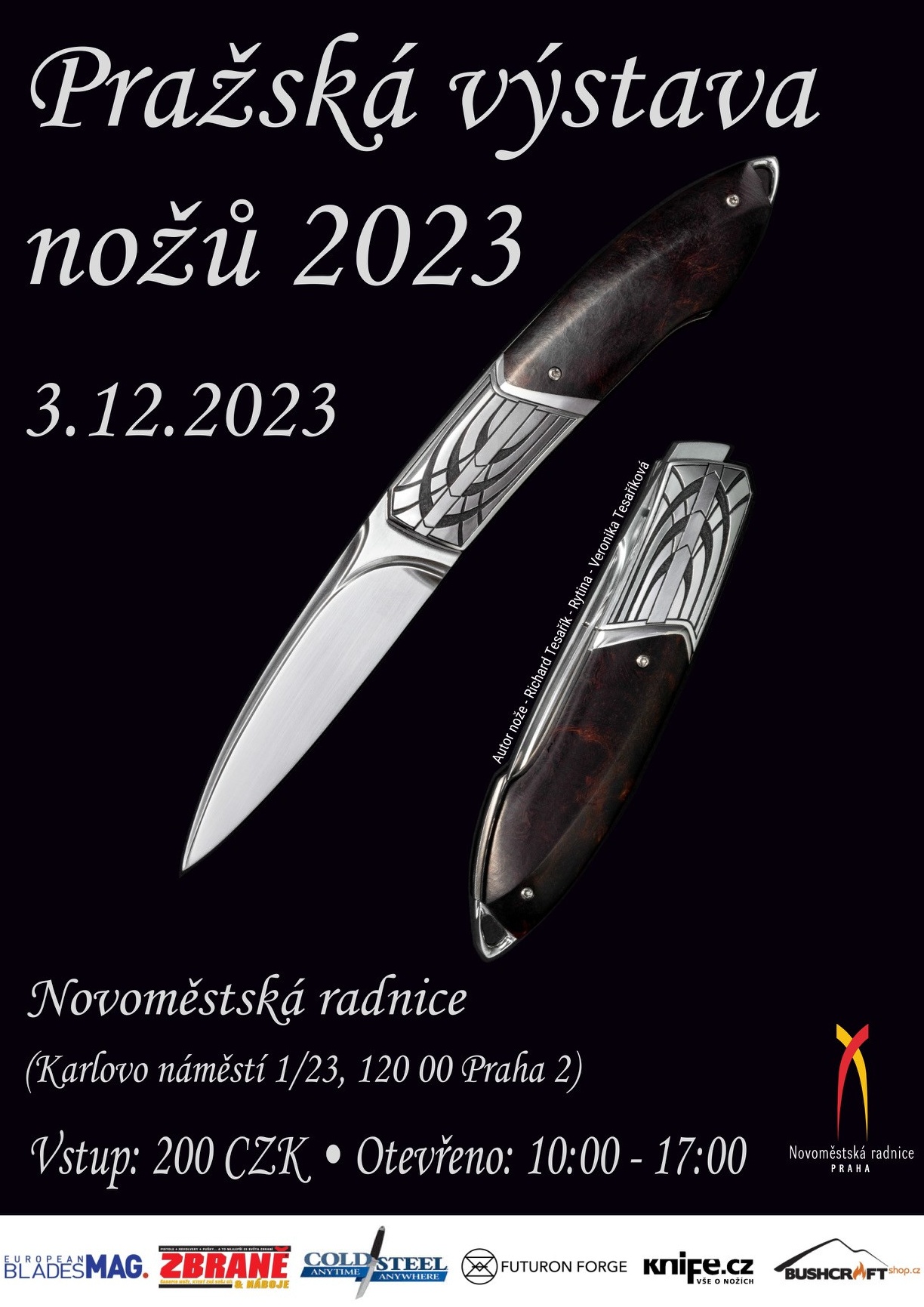

Left: the poster for the Advent exhibition. Right: The New Town Hall in a whote robe.
The first Advent Sunday belongs in the knife afficionado calendar to the exhibition held in the Prague New Town Hall. Advent of the 2023 was no exception to the rule. At the Příbram exhibition in 2023 I missed some leading knife makers. It made me glad that their tables reappeared in Prague. On the other hand, the size of the actual Prague Advent was smaller than in previous years. This concerns first of all the industrial knife production. The Dining Room of Commons (aka Mázhaus) on the ground floor, traditionally dedicated to the tables of the dealers of industrial production, was only half full. Dominant tables belonged to the dealer of Fenix flashlights, Cold steel and of the Okské nože (Oksk knives) cooperative. The last one mentioned shifted their design from traditional nordic style to a more European design. The shift is for me an indication that the majority of Okské nože clients are Europeans with European preferences.

The Great Hall, the main floor of the exhibition, shortly before opening.
An attractive table in the Mázhaus belonged to High school of applied arts from Turnov. The present student of engraving attracted many by his work, as well as the artefacts made by students. For me most attractive on the table were seminary works of the blacksmiths – a group of knives inspired (hopefully) by a dog anatomy. On one hand, I enjoyed them as an example of fascinating creativity and well executed craftmanship. On the other hand, the raised a question - are they still knives? Because the function of these objects as a cutting knife is only limited. I understand the school is focused on propagation of the arts (and to be honest, I consider the Turnov school the best school of its kind in Czech Republic) but for my whole life I believed that the design must follow the needs of function. If it is vice versa, then the object is merely a self-purposed pun. The best it can be is when the design and function go hand in hand, making a harmonic unity. Anyway, even the puns presented this year are clear evidence that in Turnov grows a new, very promising generation of artists, that will raise the imaginary colors of knife making craftmanship to new heights.
An attractive table in the Mázhaus belonged to High school of applied arts from Turnov. The present student of engraving attracted many by his work, as well as the artefacts made by students. For me most attractive on the table were seminary works of the blacksmiths – a group of knives inspired (hopefully) by a dog anatomy. On one hand, I enjoyed them as an example of fascinating creativity and well executed craftmanship. On the other hand, the raised a question - are they still knives? Because the function of these objects as a cutting knife is only limited. I understand the school is focused on propagation of the arts (and to be honest, I consider the Turnov school the best school of its kind in Czech Republic) but for my whole life I believed that the design must follow the needs of function. If it is vice versa, then the object is merely a self-purposed pun. The best it can be is when the design and function go hand in hand, making a harmonic unity. Anyway, even the puns presented this year are clear evidence that in Turnov grows a new, very promising generation of artists, that will raise the imaginary colors of knife making craftmanship to new heights.

Three very creative cutting tools – work by students from the Turnov High school of applied arts.

The table of the Turnov High school of applied arts with one of the students demonstrating engraving.
The main part of the exhibition rests in the Great Hall. Right in front of the entry stood a glassed panel announcing that Buddy Weston, one of the Czech knifemaking legends, passed away. His brief curriculum is in the accompanying text box.
In the last few years, Prague had few international participants. With pleasure I noticed this year’s presence of two Hungarian masters – Atila Kertesz (well known to readers of European Blades Mag.) and Joszef Jeneses. I enjoyed a lot especially the ‘flint’ grind of some of Kertesz’ blades, upgraded by the black DLC surface. Jeneses offered selection of kitchen knives inspired by Asian cutlery. Both Hungarian masters are fine examples of the well-balanced merger of design and function. Equally pleasant was production of Michal ‘Jakuza’ Jarý who, after a pause, returned to the exhibition floor, as well as Filip Kurota. Michal Jarý keeps the pace with (or rather was a pioneer of) the modern trend of core sandwich blades which have the hard core connected with the outer sheath by a layer of some other, typically very pure, colored metal, typically either copper or nickel. In respect to his Asian oriented nickname (Jakuza) Jarý experiments with sandwiches of different metals that ultimately result in a layered, colorful structures. The bolsters of his folding knife are the evidence of his capability. Kurota presented a series of three folding knives with unlocked blades and wooden scales. They resembled a knife that me and my late father had once upon a time, even they had the wooden scales.
Jiří ‘Turtle’ Hrála presented a new, respectively modified mechanism of back lock folding knife. He also brought with him a new knifemaker, Noemi ‘Noi’ Heřtovou. Regular readers may remember that two fixed blade knives made by this (at that time a child) girl appeared some five years ago at Hrála’s table. At that time it was more a game than serious production, no matter how well the knives were made. That girl is a miss now and presented simple, but well-crafted knives (here the tutorial role of ‘Turtle’ is undisputable) under her own mark ‘Noi’ proudly stamped on the blade. I am looking forward for the future of this young miss. The beginnings are promising.
The main part of the exhibition rests in the Great Hall. Right in front of the entry stood a glassed panel announcing that Buddy Weston, one of the Czech knifemaking legends, passed away. His brief curriculum is in the accompanying text box.
In the last few years, Prague had few international participants. With pleasure I noticed this year’s presence of two Hungarian masters – Atila Kertesz (well known to readers of European Blades Mag.) and Joszef Jeneses. I enjoyed a lot especially the ‘flint’ grind of some of Kertesz’ blades, upgraded by the black DLC surface. Jeneses offered selection of kitchen knives inspired by Asian cutlery. Both Hungarian masters are fine examples of the well-balanced merger of design and function. Equally pleasant was production of Michal ‘Jakuza’ Jarý who, after a pause, returned to the exhibition floor, as well as Filip Kurota. Michal Jarý keeps the pace with (or rather was a pioneer of) the modern trend of core sandwich blades which have the hard core connected with the outer sheath by a layer of some other, typically very pure, colored metal, typically either copper or nickel. In respect to his Asian oriented nickname (Jakuza) Jarý experiments with sandwiches of different metals that ultimately result in a layered, colorful structures. The bolsters of his folding knife are the evidence of his capability. Kurota presented a series of three folding knives with unlocked blades and wooden scales. They resembled a knife that me and my late father had once upon a time, even they had the wooden scales.
Jiří ‘Turtle’ Hrála presented a new, respectively modified mechanism of back lock folding knife. He also brought with him a new knifemaker, Noemi ‘Noi’ Heřtovou. Regular readers may remember that two fixed blade knives made by this (at that time a child) girl appeared some five years ago at Hrála’s table. At that time it was more a game than serious production, no matter how well the knives were made. That girl is a miss now and presented simple, but well-crafted knives (here the tutorial role of ‘Turtle’ is undisputable) under her own mark ‘Noi’ proudly stamped on the blade. I am looking forward for the future of this young miss. The beginnings are promising.

The face behind the new mark ‘Noi’: Noemi Lea Heřtová.
David Brož (mark 'Knifet') offered a very nice, fixed blade knife. The combination of ebony and palm wood on the grip makes attractive contrast and the knife as such really appealed to me. Distinctive knives inspired by the medieval everyday carry cutlery are made for years by Filip ‘Yeller’ Ondruška. This time he offered a pretty small knife with an oakwood handle and a knife whose grip combined bone and wooden scales decorated by rivets with washers. A similar knife but with antler grip and patina brass bolster was presented Jakub Petráš. The blade is from a reforged file, referring to the tradition from the days when quality iron was scarce. Arkady Dabakyan also went the way of copper sandwich blades, which is another proof of an already recognized blacksmith of a high degree. His knives have a distinctive design, they are perfectly made, highly functional and handsome for work. Simple design enables easy maintenance – cleaning of an engraved hunting knife covered by blood is nothing easy nor pleasant. A fine knife with sandwich blade was presented D. Brosch. Max Netrval presented a hunting knife with a red deer antler grip decorated by deep cut relief with deer game motif. For Max this is a step aside from his more common Nordic knives. On the contrary towards the Nordic style stepped Miroslav Pouzar, which is obviously enjoying a very creative period. Polish cutlery Libra offered semi-industrially made knives with distinctive S shaped silhouette. Kotěra knives broadened the offer of their replicas of classic 1st World War trench knives with new replica of John Ek Commando used in Vietnam war by US Marines commando units.
There were less folding knives than fixed blades. Knives by Kurota and Hrála I already mentioned, and there was a table of luxurious folders from Mr. and Mrs. Tesařík. I remarked knives by Václav Čížek. Related by copper (or some metal with heavy majority of copper) bolster, knives were both large and small, all with liner lock and very smooth operation. The already mentioned Miroslav Pouzar already offered large folding filleting knife (something very unusual in our grounds) together with a massive Spanish style albacete in a characteristic elaborated Pouzar style leather pouch. Attractive folders with blades made from a premium stainless damask steel presented Futuron Forge, together with new patterns of stainless steel damask billets. Finally, let me point out three folders by Petr Vorel. They are all of different type (navaja with a spring lock, classic farmer folding knife and simple folder with lathe turned handle) all related by the very, very retro style, simple yet uncompromising functional design and a rural retro elegance.
Prague Advent 2023 was a good exhibition, still my mind was full of thoughts about the future of knife exhibitions. I feel that they fail to return to the pre-covid level. The absence of the industrial production was obvious. I am not sure but I have a feeling that even the young knife makers are more and more moving to the cyber space, to social media. Facebook seems already bristling by young people who made ‘some knife’. The key is the word ‘some’ – I cannot assess the quality of a knife based only on pictures on Facebook or Instagram. All I can do is appeal to the readers: Don’t be afraid and bring your knives (and bacon) to the exhibition and let the visitors judge. The crowd is fair and no matter if you are hobbyist or professional, you will find your place in the ranks. And might even be pleasantly surprised.
When you read these lines, Christmas will be over and we will be in the year 2024. I wish you that this year will be better than the one that has just passed to history.
David Brož (mark 'Knifet') offered a very nice, fixed blade knife. The combination of ebony and palm wood on the grip makes attractive contrast and the knife as such really appealed to me. Distinctive knives inspired by the medieval everyday carry cutlery are made for years by Filip ‘Yeller’ Ondruška. This time he offered a pretty small knife with an oakwood handle and a knife whose grip combined bone and wooden scales decorated by rivets with washers. A similar knife but with antler grip and patina brass bolster was presented Jakub Petráš. The blade is from a reforged file, referring to the tradition from the days when quality iron was scarce. Arkady Dabakyan also went the way of copper sandwich blades, which is another proof of an already recognized blacksmith of a high degree. His knives have a distinctive design, they are perfectly made, highly functional and handsome for work. Simple design enables easy maintenance – cleaning of an engraved hunting knife covered by blood is nothing easy nor pleasant. A fine knife with sandwich blade was presented D. Brosch. Max Netrval presented a hunting knife with a red deer antler grip decorated by deep cut relief with deer game motif. For Max this is a step aside from his more common Nordic knives. On the contrary towards the Nordic style stepped Miroslav Pouzar, which is obviously enjoying a very creative period. Polish cutlery Libra offered semi-industrially made knives with distinctive S shaped silhouette. Kotěra knives broadened the offer of their replicas of classic 1st World War trench knives with new replica of John Ek Commando used in Vietnam war by US Marines commando units.
There were less folding knives than fixed blades. Knives by Kurota and Hrála I already mentioned, and there was a table of luxurious folders from Mr. and Mrs. Tesařík. I remarked knives by Václav Čížek. Related by copper (or some metal with heavy majority of copper) bolster, knives were both large and small, all with liner lock and very smooth operation. The already mentioned Miroslav Pouzar already offered large folding filleting knife (something very unusual in our grounds) together with a massive Spanish style albacete in a characteristic elaborated Pouzar style leather pouch. Attractive folders with blades made from a premium stainless damask steel presented Futuron Forge, together with new patterns of stainless steel damask billets. Finally, let me point out three folders by Petr Vorel. They are all of different type (navaja with a spring lock, classic farmer folding knife and simple folder with lathe turned handle) all related by the very, very retro style, simple yet uncompromising functional design and a rural retro elegance.
Prague Advent 2023 was a good exhibition, still my mind was full of thoughts about the future of knife exhibitions. I feel that they fail to return to the pre-covid level. The absence of the industrial production was obvious. I am not sure but I have a feeling that even the young knife makers are more and more moving to the cyber space, to social media. Facebook seems already bristling by young people who made ‘some knife’. The key is the word ‘some’ – I cannot assess the quality of a knife based only on pictures on Facebook or Instagram. All I can do is appeal to the readers: Don’t be afraid and bring your knives (and bacon) to the exhibition and let the visitors judge. The crowd is fair and no matter if you are hobbyist or professional, you will find your place in the ranks. And might even be pleasantly surprised.
When you read these lines, Christmas will be over and we will be in the year 2024. I wish you that this year will be better than the one that has just passed to history.

A fixed blade by Oksk knives, with a Carbon Damask blade and Moose Bone handle.

A knife by Noemi Heřtová. The blade is 14 260, the handle material is beech. Overall length is 297 mm.

Two well-crafted knives by Noemi ‘Noi’ Heřtová. Both have a 12C27N blade. The left one has Walnut
handle, the right one Red Deer Antler. Overall length is 112 and 160 mm respectively.

Mock-up of a modified back lock on the table of of Jiří ‘Turtle’ Hrála.

Three slip joint folders by Filip Kurota. The blades are 14C27N, the handle scales are Elderberry and
Silver. Overall length when opened is 196 mm.
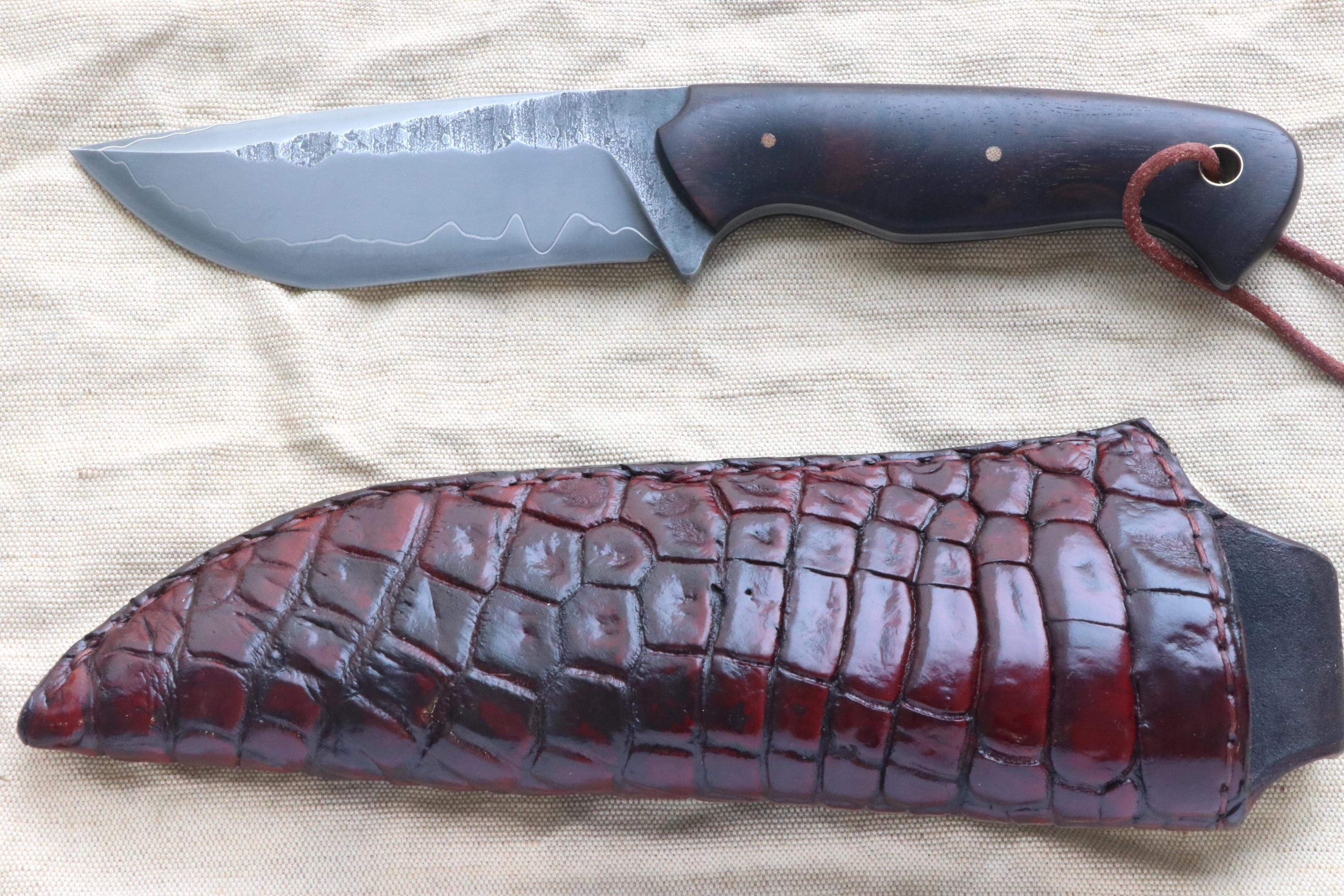
An outdoor knife by Michal ‘Jakuza’ Jarý. The 115 mm blade is Sleipner, nickel and AK5, the handle is
Ironwood.

Filip ‘Yeller’ Ondruška showed this fixed blade, from 19 356 steel with an Oak handle. Overall length is
185 mm.

An outdoor knife by Filip Ondruška. The blade is 19 356 steel, the handle is Ebony. Overall length is 178 mm.
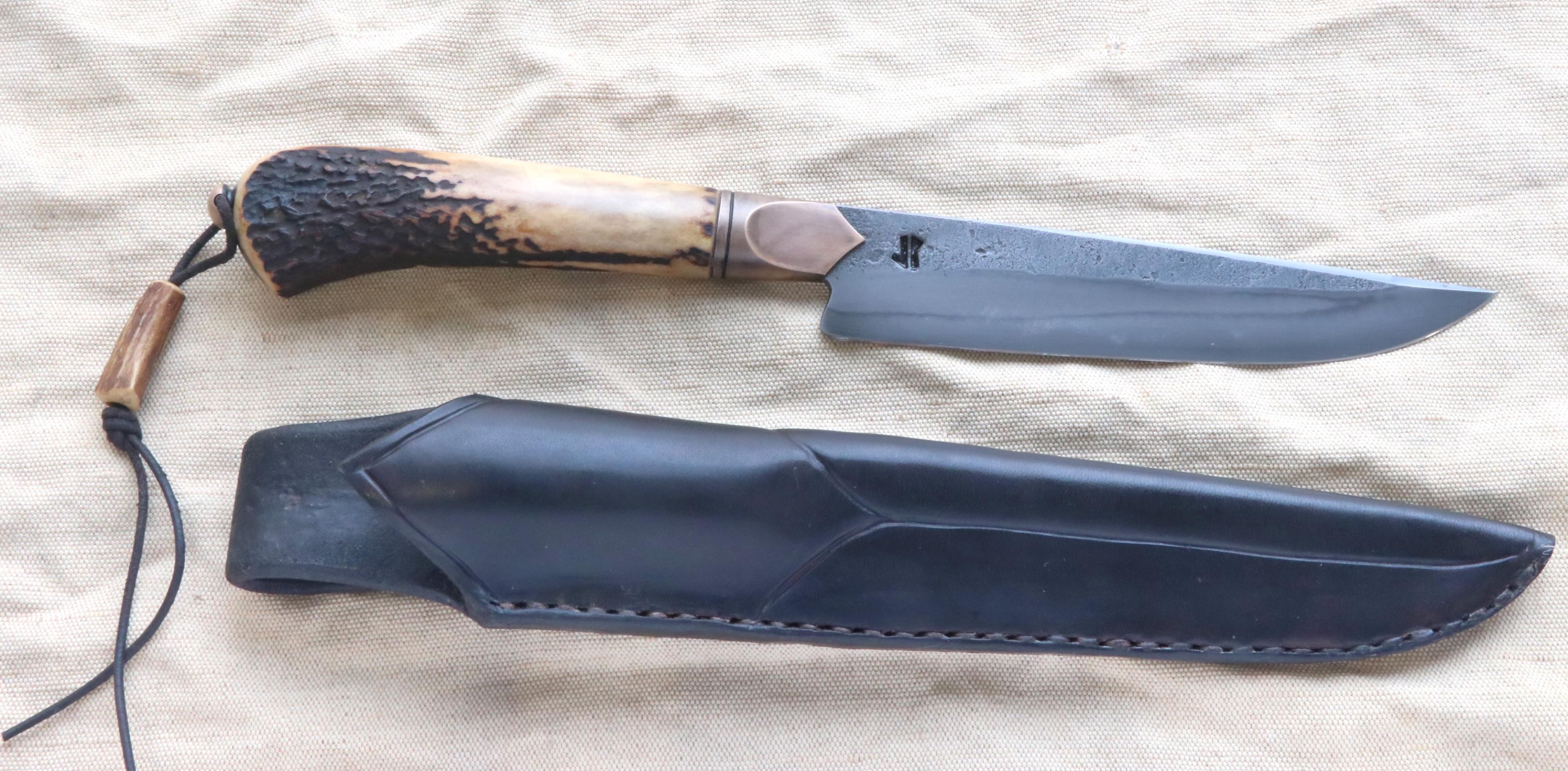
The 181 mm blade of this knife by Jakub Petráš is made from an old file. The handle is Bronze
and Red Deer Antler.

What looks like flint is in fact RWL34 on this knife by Atila Kertesz. The handle is Packwood. Overall
length is 233 mm.

This knife by Atila Kertesz has a 100 mm D2 blade with DLC and Mammoth handle scales. The engraving
on the bolsters is by Kristóf Som.

David Brož (‘Knifet’) offered this fixed blade knife, with an N690 blade and a handle from Ebony and
Palmwood. Overall length is 284 mm.

A kitchen knife by Radim Dachs. The 205 mm blade is WG10, the handle is Stained Birch.

An attractive sandwich blade by Arkady Dabakyan, made from stainless and Copper. The handle is Red
Deer Bone and Birch. Overall length is 220 mm.

Another example of a Dabakyan sandwich blade, this time with a Red Deer Bone handle. Overall length
is 200 mm.

The ‘Dragon’ by Libra Knives from Poland. The blade is K720, the handle scales are G10. Overall length
is 242 mm.

Two linerlock folders by Václav Čížek. Both have a San Mai Elmax blade, of 105 and 120 mm respectively.
The bigger knife has Copper bolsters and an Ostrich Bone handle, the smaller one has a Copper bolster
and Fat Carbon handle.


Two examples of the ‘Darken knife’ by Jiĭrí Cígler. Both have a 19 191 blade, of 100 and 110 mm
respectively. The handle material is Ebony (top) and African Wood.

A new replica of the John Ek Commando by Kotěra Knives. The 160 mm blade is 14 260, the handle is Oak.

M. Brosch presented this knife with a 19 312 and nickel steel blade and an Alder handle. Overall length
is 275 mm.
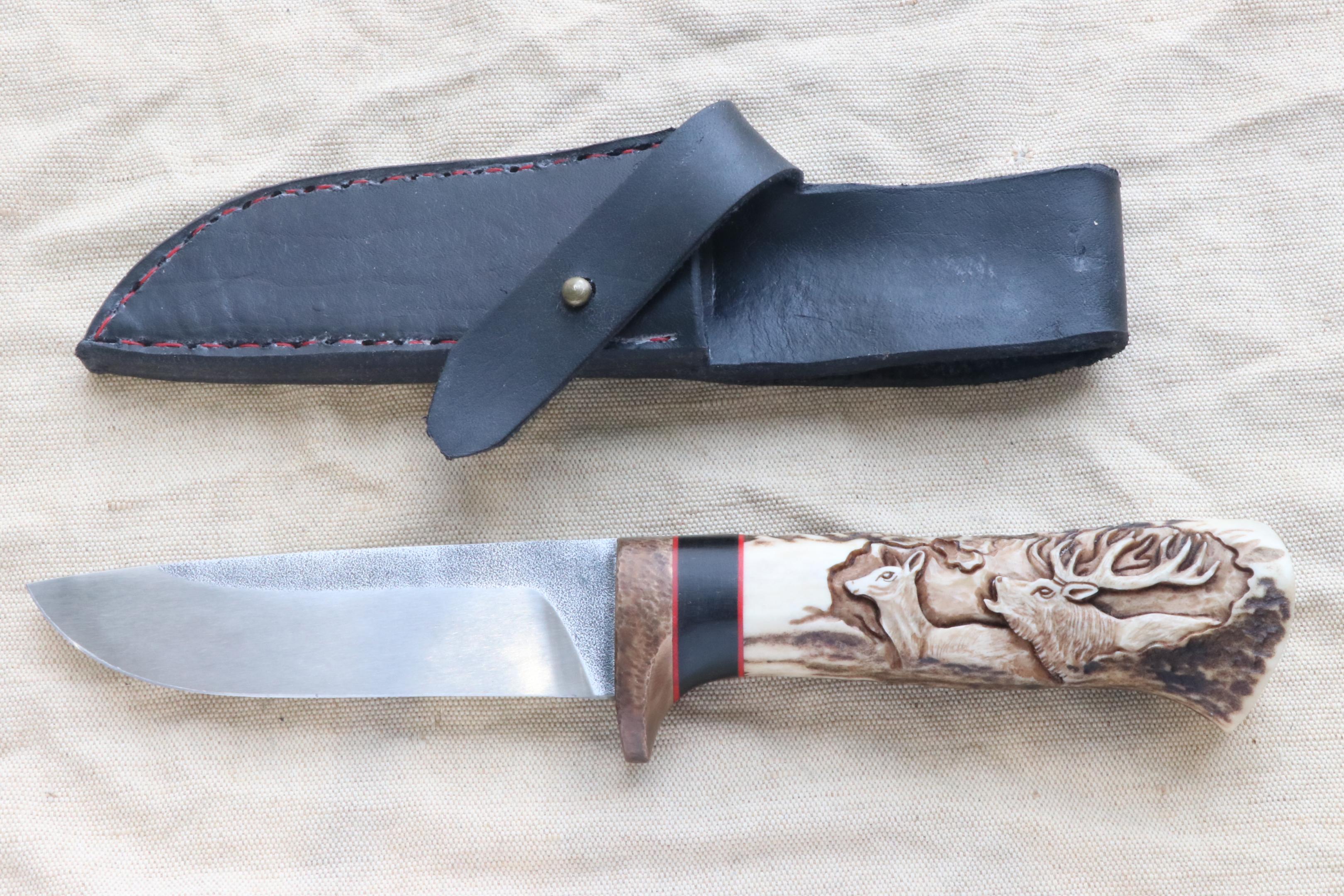
Max Netrval presented this hunting knife with a red deer antler grip decorated by deep cut relief with deer
game motif. The 115 mm blade is D2.

A Nordic style knife by Miroslav Pouzar. The 140 mm blade is Carbon Damask, the handle is Birch.

A liner lock folder by Miroslav Pouzar. The 140 mm blade is Carbon Damask, the handle is Mouflon
and Titanium.

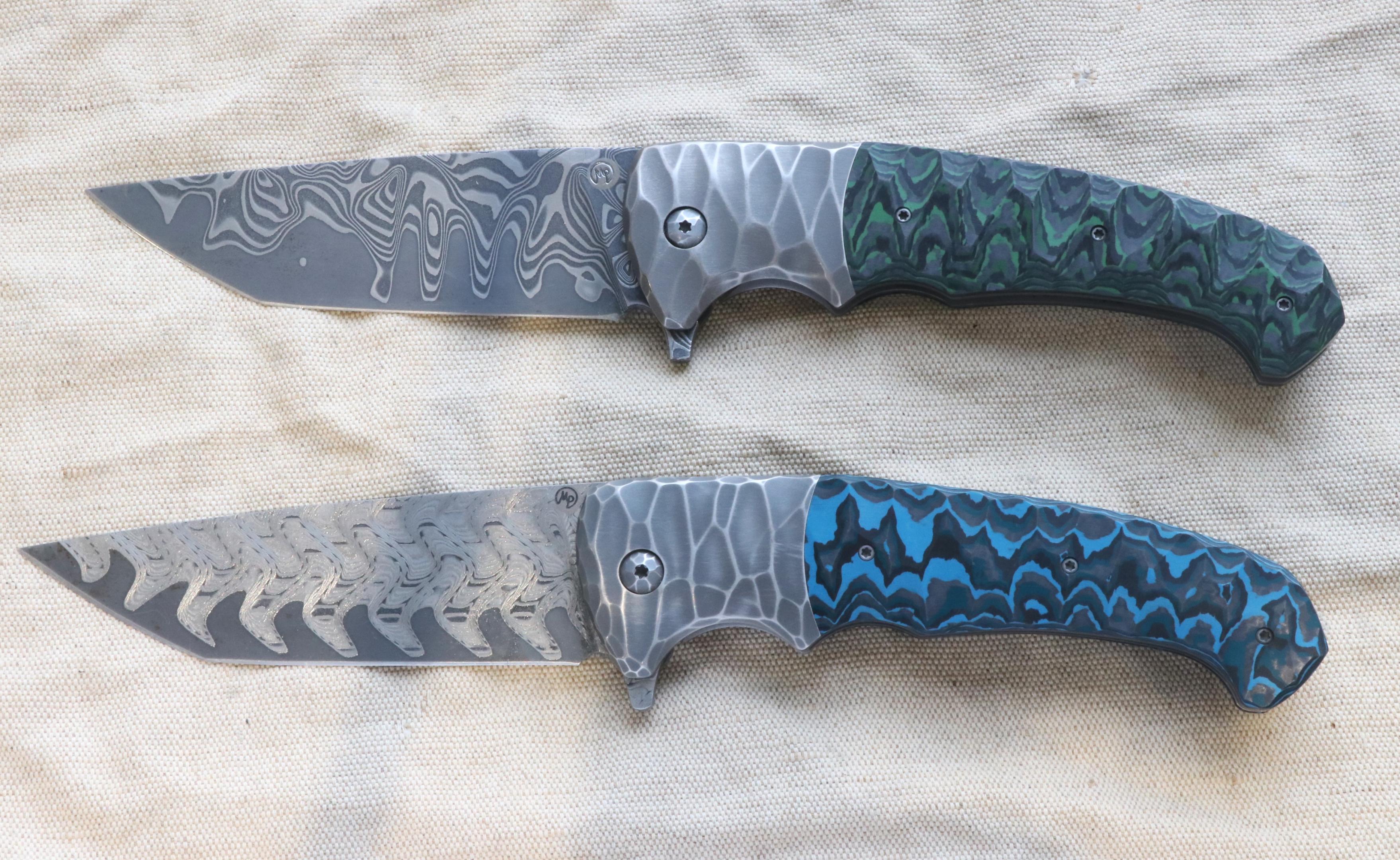
Two liner lock folders by Futuron Forge. The 100 mm blades are their own stainless Damask, the handle
scales are Fat Carbon.

A liner lock folder by Miroslav Pouzar. The 140 mm blade is N690, the handle is Acacia.

A kitchen knife by Joszef Jeneses. The 232 mm blade is Agagami.

Three folders by Petr Vorel of different type (Navaja with a spring lock, classic farmer folding knife and
simple folder with a lathe turned handle). The blades are all Carbon Steel, measuring 85 mm, 85 mm
and 135 mm respectively.